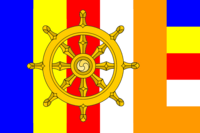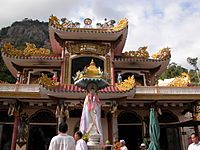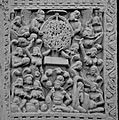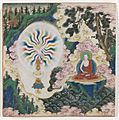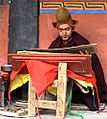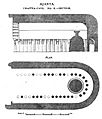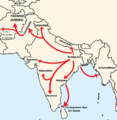Buddhism facts for kids
Buddhism originated in India, based on the teachings of Siddhartha Gautama, later known as Gautama Buddha. A Buddha is one who is said to be awake to the truth of life. Buddha is a Pali word which means "the awakened one." According to Buddhism, there were countless Buddhas before Gautama Buddha, and there will be many Buddhas after him.
Over the centuries, Gautama Buddha's teachings spread from Nepal to Central Asia, Tibet, Sri Lanka, Southeast Asia, China, Mongolia, Korea, Japan, Europe, North, and South America. Theravada Buddhism is most common in South Asia; Mahayana is most common further north. Buddhism exists in many different strands today, but all versions share basic ideas. About seven percent of the people of the world are Buddhist.
While many people see Buddhism as a religion, others see it as a philosophy, and others as a way of finding reality.
Contents
Background and Buddhist concepts
Siddhartha Gautama (563–483 BC) began life as the infant prince of a small kingdom in what is now the southern part of Nepal. As an adult, he left wealth and status behind to search for truth. The Buddha spent the next 45 years of his life traveling and teaching in the northern part of India. He died at the age of 80.
The Buddha focused much of his teaching on how to overcome suffering. He saw that all living things suffer. He taught that by overcoming suffering, a person will be truly happy.
He began teaching holy men or monks the Four Noble Truths of Life and the Eightfold Noble Path (see below). These teachings identify the causes of suffering and their cure. The Buddha taught that there are three marks of existence: He said life is best understood as being impermanent (everything changes), unsatisfactory (left on our own we are never truly happy), and interdependent (all things are linked).
In discussing suffering, the Buddha identified the "three poisons" of desire, anger, and stupidity, and he showed that we could end our suffering by letting go of desires and overcoming anger and stupidity.
The complete letting go of negative influences is called Nirvana, meaning "to extinguish," like putting out the flame of a candle. This end of suffering is also called Enlightenment. In Buddhism, Enlightenment and Nirvana often mean the same thing.
The Buddha taught that living in balance is the best way to live. He called this "the middle way." He also recommended meditation as a way to train the mind to see the world as it is.
The Buddha taught that actions have consequences for good or bad. People who make good decisions will be happier and have more peace of mind. This is called karma.
Another teaching of Buddhism is reincarnation – the idea that when people die, they will be reborn as someone or something else. They live their life the best they can in hopes of reincarnating as something better until they eventually reach enlightenment.
Buddhists would not say whether or not there is a God or gods. Buddhists do not believe that people should look to gods to save them or bring them enlightenment. Instead, they believe individuals should work out their own path the best they can. Many of the Buddha's ideas are found in other Indian religions, especially Hinduism.
Beliefs of Buddhism
The three jewels
Buddhists respect and treasure the Three Jewels, which are the Buddha, the Dharma, and the Sangha.
The Buddha refers to the awakened one, the Dharma to the Buddha's teachings, and the Sangha to the people who follow the Buddha and his teachings.
Buddhists say "I take refuge in the Buddha, the Dharma, and the Sangha." They find comfort in these jewels or treasures.
Four Noble Truths
The Buddha's first and most important teachings are the Four Noble Truths.
- Life is suffering.
- The reason for this suffering is that we want things to be a certain way.
- The way to cure suffering is to rise above this desire.
- The way to rise above desire is to follow the Noble Eightfold Path, practices which help us change our minds and understanding.
Noble Eightfold Path
The Buddha told people to follow a special way of life called the Noble Eightfold Path if they want to understand the Four Noble Truths. These are:
- Appropriate views. Know and understand the Four Noble Truths.
- Appropriate thought. Turn your mind away from the world and toward the Dharma.
- Appropriate speech. Tell the truth, don't gossip, and don't talk badly about others.
- Appropriate conduct. Don't commit evil acts, like killing, stealing, or living an unclean life.
- Appropriate livelihood. Earn your money in a way that doesn't harm anyone.
- Appropriate effort. Work to make your mind more good and less evil.
- Appropriate mindfulness. Remember the Dharma and apply it all the time.
- Appropriate meditation. Practice meditation as a way of understanding reality.
Five precepts
Buddhists are encouraged to follow five precepts, or guidelines:
- I will not hurt a person or animal that is alive.
- I will not take something if it was not given to me.
- I will not engage in sexual misconduct.
- I will not lie or say things that hurt people.
- I will not take intoxicants causing heedlessness.
If a person wants to be a monk or nun, he or she will follow other precepts as well.
Interesting facts about Buddhism
- The term "Buddhism" was invented by Western scholars in the 1830s. Buddhists don’t refer to their religion as “Buddhism.”
- The Buddha founded an order of monks and nuns known as the Sangha who have preserved his teachings.
- Because of its emphasis on meditation and mindfulness, Buddhism is often considered to be a form of psychology rather than a religion.
- In Buddhism, there is no single holy book.
- Buddhists do not believe in a supreme being or creator God.
- A Buddha is a person who has reached enlightenment.
- Buddhist monks and nuns shave their hair.
- In Buddhism, each person must work their way to enlightenment.
Related pages
Images for kids
-
An image of a lantern used in the Vesak Festival, which celebrates the birth, enlightenment and Parinirvana of Gautama Buddha.
-
The gilded "Emaciated Buddha statue" in an Ubosoth in Bangkok representing the stage of his asceticism
-
Traditional Tibetan Buddhist Thangka depicting the Wheel of Life with its six realms
-
Ramabhar Stupa in Kushinagar, Uttar Pradesh, India is regionally believed to be Buddha's cremation site.
-
An aniconic depiction of the Buddha's spiritual liberation (moksha) or awakening (bodhi), at Sanchi. The Buddha is not depicted, only symbolized by the Bodhi tree and the empty seat.
-
Bodhisattva Maitreya, Gandhara (3rd century), Metropolitan Museum of Art.
-
Sermon in the Deer Park depicted at Wat Chedi Liam, near Chiang Mai, Northern Thailand.
-
Buddhist monks collect alms in Si Phan Don, Laos. Giving is a key virtue in Buddhism.
-
Kōdō Sawaki practicing Zazen ("sitting dhyana")
-
Statue of Buddha in Wat Phra Si Rattana Mahathat, Phitsanulok, Thailand
-
Ajanta Caves, Cave 10, a first period type chaitya worship hall with stupa but no idols.
-
Sanchi Stupa No. 3, near Vidisha, Madhya Pradesh, India.
-
Map of the Buddhist missions during the reign of Ashoka according to the Edicts of Ashoka.
-
A Buddhist triad depicting, left to right, a Kushan, the future buddha Maitreya, Gautama Buddha, the bodhisattva Avalokiteśvara, and a monk. Second–third century. Guimet Museum
-
Site of Nalanda University, a great center of Mahāyāna thought
-
Angkor Thom build by Khmer King Jayavarman VII (c. 1120–1218).
-
Ruins of a temple at the Erdene Zuu Monastery complex in Mongolia.
-
Buryat Buddhist monk in Siberia
-
1893 World Parliament of Religions in Chicago
-
Interior of the Thai Buddhist wat in Nukari, Nurmijärvi, Finland
-
A painting by G. B. Hooijer (c. 1916–1919) reconstructing a scene of Borobudur, the largest Buddhist temple in the world.
-
Frontispiece of the Chinese Diamond Sūtra, the oldest known dated printed book in the world
See also
 In Spanish: Budismo para niños
In Spanish: Budismo para niños


